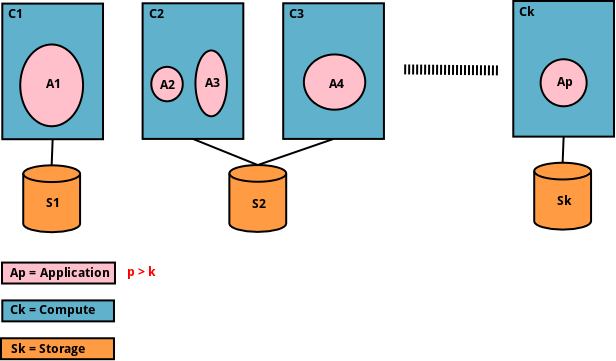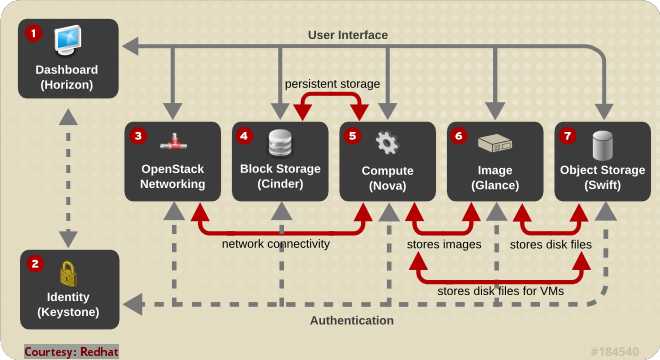Introduction to OpenStack
Traditionally, Enterprise infrastructure team would deploy actual
servers (compute nodes) and/or storage hardware in one or more data
centers based on the demand from application teams.
For example, one application (A1) could request one or more servers
(compute nodes) with a certain requirements (8 Cores, 64GB RAM) and
storage (20 TB with 1000 read iops and 1000 write iops). Another
application (A2) may request one or more servers (compute nodes) with
other requirements (4 Cores, 32GB RAM) and storage (5 TB with 200 read
iops and 200 write iops) and so on.
Enterprise infrastructure team typically decide on a few standard
configurations for servers (compute nodes) and storage. For example,
high-end server (64 Cores, 128GB RAM) and a generic server (32 Cores,
64GB RAM) for the compute nodes, etc.
The following illustrates this traditional approach to deploying
applications on a dedicated server (a compute node may be shared amongst
one or more applications) and probably sharing a dedicated storage:

Traditional Deployment
Pros and Cons with this traditional approach:
-
PROs :: application resource isolation
-
CONs :: administration complexity,
under-utilized resources, time and cost
Enter Virtualization.
With virtualization, the enterprise infrastructure team would install
hypervisors on physical servers (compute nodes) and effectively allocate
virualized servers (compute node) from a single physical server to
application teams.
The following illustrates this virtualization approach to deploying
applications on virtual servers and probably sharing a dedicated
storage:

Virtualization Deployment
Pros and Cons with this virtualization approach:
-
PROs :: application resource isolation,
better system resource utilization
-
CONs :: administration complexity, cost
The next evolution - the Cloud.
One would often hear the term - Infrastructure as a
Service (or IaaS) in the Cloud
lingo. With IaaS, the system resources such as physical servers (compute
nodes), storage, and network are virtualized and made available to
applications over the Internet.
With Cloud, the enterprise infrastructure team would manage system
resources (server, storage, and network) using a Cloud platform such as
OpenStack.
The following illustrates this Cloud approach to deploying
applications:

Cloud Deployment
Pros and Cons with this cloud approach:
-
PROs :: better system resource
utilization, dynamic resource provisioning and deployment
-
CONs :: constantly evolving, talent,
complex administration
OpenStack is a free and open-source cloud
computing software platform that can be used to implement Infrastructure
as a Service (IaaS) environment.
OpenStack consists of the following set of inter-related core services
that come together to form the IaaS environment:
-
Keystone :: Identity and access
-
Glance :: Virtual machine images
-
Neutron :: Networking
-
Cinder :: Block storage
-
Swift :: Data object storage
-
Nova :: Compute instances
-
Horizon :: Management dashboard
OpenStack exposes REST based API to create
and manage the various resources in the cloud.
In the sections below, we will describe each of the above mentioned
core servicesat a high-level.
Provides Identity (authentication) and Access management
(authorization) services for OpenStack.
-
Manage users, groups, and roles
-
Manage services and endpoints of all the components in the cloud
-
Manage user permissions to access various services and endpoints
Provides virtual machine image management services for OpenStack.
Provides virtual network management services for OpenStack.
Provides block device storage management services for OpenStack.
Provides the object storage management services for OpenStack.
Provides virtual server instance (compute node) management services for
OpenStack.
-
Create server (compute) instances on demand using the virtual
machine guest images from Glance with the desired virtual network
configuration
-
Manage attachment/detachment of storage volumes to server (compute)
instances
Provides a web-based management dashboard for OpenStack.
The following illustrates all the above mentioned components
that make the OpenStack Cloud environment:

OpenStack Cloud



